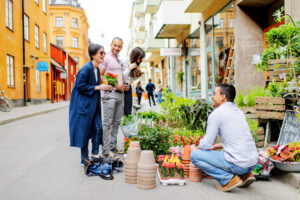Densification aims to optimize urban spaces, improving residents’ quality of life by ensuring easy access to services, public transport, and amenities. A well-planned, dense city can promote environmental sustainability and social inclusion.
Densification has been a key strategy for developing more sustainable cities in recent decades. It involves planning urban areas to optimize the use of resources and the physical environment. By utilizing underused spaces, such as former industrial land in inner cities, cities can grow while making the most out of available space.
Planning for mixed-use development is also essential to enhance the everyday lives of residents. Ensuring that different destinations, like shops, schools, amenities, and workplaces, are within walking distance or easily accessible by sustainable transport, like bicycle or public transport, greatly improves residents’ quality of life.
Proximity to activities and accommodation

Image by Simon Paulin/imagebank.sweden.se
City life surveys consistently show that proximity to activities and accommodation is the most important factor for residents living in a city. These surveys also reveal that cities with high levels of interaction are typically preferred, where density promotes social engagement.
In recent years, concepts advocating for mixed-use urban design, such as the “compact city” and the “15-minute city,” have gained significant interest. These models focus on providing access to services and amenities within walking or cycling distance from people’s homes, offering a more sustainable and convenient lifestyle while promoting a stronger sense of community.
Challenges of a densified city
While densification brings numerous benefits, it is not without challenges. Higher density increases pressure on public spaces and creates a greater demand for public and commercial services. It’s crucial that cities accommodate diverse groups, including children, the elderly, people with disabilities, and people of different genders and backgrounds, in these increasingly dense environments.
Green spaces are necessary for recreation, climate adaptation, and ecosystem services. However, as the number of visitors and residents grows, these spaces can become more worn and less effective. Land that had previously been left undeveloped due to poor characteristics (such as high noise levels) may be repurposed. In densely built environments, creating high-quality indoor and outdoor spaces with adequate access to sunlight and daylight can be challenging. Moreover, there is a limit to the capacity of existing technical infrastructure to handle increased demands.
For sustainable development, the use of the city’s resources needs to be handled consciously, and one surface might have to be used for several purposes. Balancing densification with the preservation of green spaces, social inclusion, and maintaining the efficiency of technical systems is essential for creating a livable, resilient city.
Sweden’s Approach to Sustainable Densification
Numerous urban development projects in Sweden focus on densification and multifunctionality to promote both environmental and social sustainability. These initiatives aim to reduce environmental impact while being designed to foster social interaction, offering a model for how densification can create more sustainable and inclusive communities.